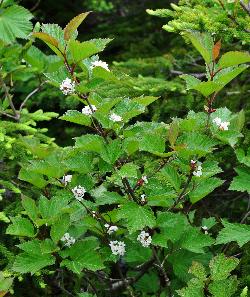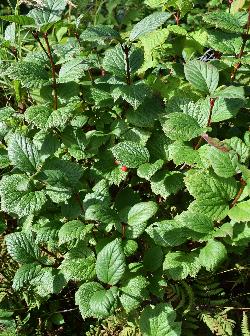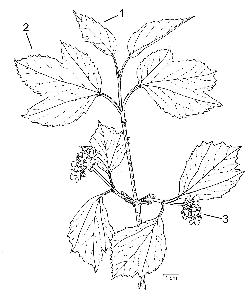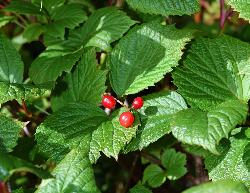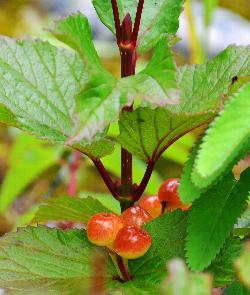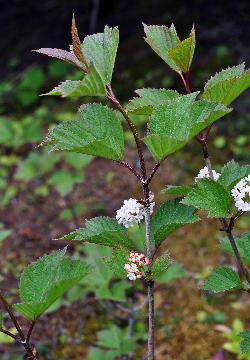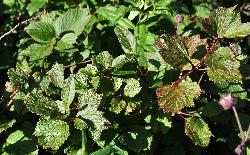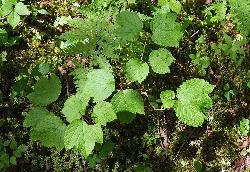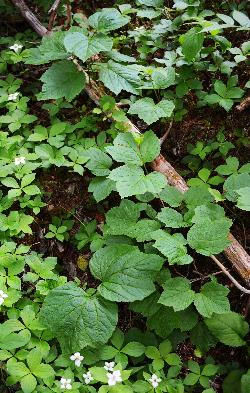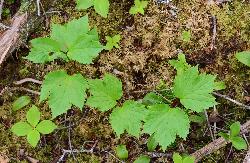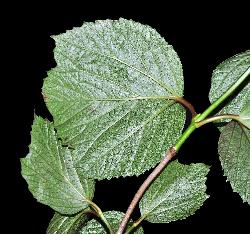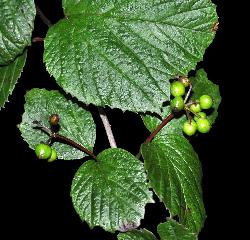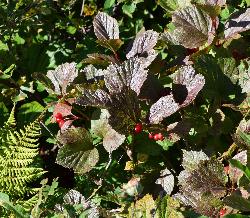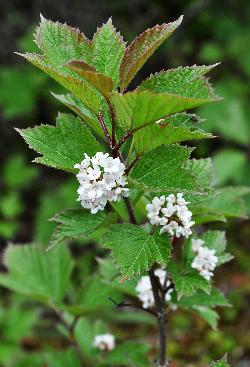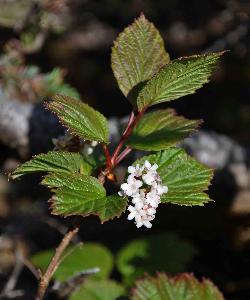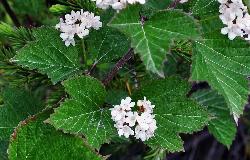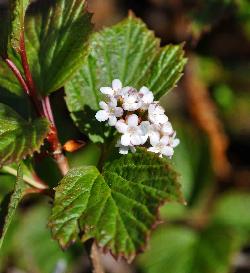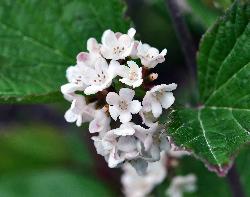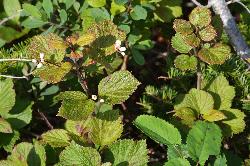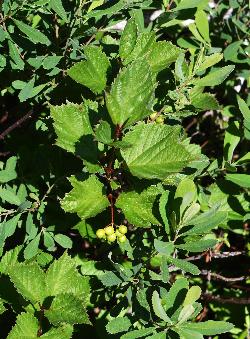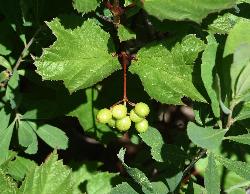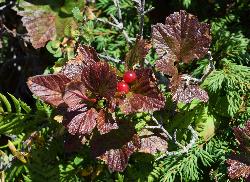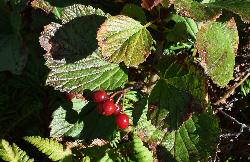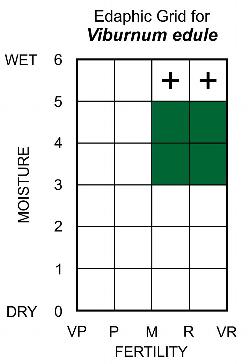Fr: viorne comestible
IA: mushuminakashi, mushumin
Viburnaceae - Viburnum Family
Note: Numbers given in square brackets in the text refer to the images presented above; image numbers are displayed to the lower left of each image.
General: A low to medium-height deciduous shrub, 0.5–2 m tall, with spreading to erect branches [1–3]. Squashberry shrubs are rhizomatous, roots in the organic layer, and can reproduce vegetatively through layering or sprouts after the roots or stems are damaged (Matthews 1992). Ripe squashberry fruits make a delicious jam, which is available locally in Newfoundland. In western Canada, where it grows considerably taller than in eastern Canada, this species is commonly called highbush cranberry. Squashberry shrubs provide cover, browse, and edible fruit for moose, snowshoe hares, and a variety of small mammals and birds (Matthews 1992).
Key Features: (see numbers 1–3 indicated on the illustration [4])
- Young leaves are simple and elliptic, with tapering to rounded bases, serrate margins, and sharply pointed apices. As the leaves mature, they expand into 3-lobed leaves.
- Mature leaves have broader lobes with toothed (dentate to serrate) margins and pointed (acute to acuminate) apices.
- Inflorescences are few-flowered and terminal on short lateral branches; the flowers are all similar in size, with pink-tinged buds that open to creamy-white flowers with 5-lobed corollas.
- A few berry-like fruit (drupes) are borne in small clusters on lateral branches; the mature fruit are red, fleshy, and edible, although mainly used to make jam [5].
Stems/twigs: Twigs are glabrous with purplish-brown to grey bark. Lateral buds are opposite; both terminal and lateral buds are oblong to ovoid and blunt, with 2 dark reddish-brown outer bud scales that are valvate and connate [6]. Flower buds occur at the end of lateral branches. Mature stems have glabrous greyish-brown bark.
Leaves: Opposite, simple, petiolate, and 3-lobed at maturity. Petioles are 0.5–4 cm long, slightly hairy, and often reddish; stipules are lacking, but a pair of small glands usually occurs at the junction of the petiole and the leaf blade. Emerging leaves on each shoot are simple and unlobed, elliptic to ovate [7–8], with pinnate venation, blunt to rounded bases, sharply serrate margins, and pointed (acute to acuminate) apices; as leaves mature, they become shallowly 3-lobed [9]. Mature leaves are 4–12 cm long and 2.5–12 cm wide, broadly ovate to nearly orbicular in outline, 3-lobed, and palmately-veined with 3–5 major veins [10–12]; bases are rounded to truncate, apices are blunt to sharply pointed (acuminate). Leaf blades are dark green and glabrous above, barely paler beneath and finely hairy, especially along the veins and leaf margins [13]. Fertile lateral branches bear only 2 leaves, which are smaller than the leaves on vegetative shoots [14]. Leaves turn orange, red, or purplish-red in autumn [15].
Flowers: Bisexual; arranged in few-flowered rounded clusters (compound cymes), 1.5–2.5 cm across, at the end of short lateral branches arising from the previous year's growth [16–18]. All flowers of the inflorescence are fertile and of approximately the same size. The calyx is inconspicuous, with 5 small triangular lobes; the milky-white short-campanulate corolla has 5 rounded lobes, tinged with pink in bud and on the lower corolla surface; the 5 stamens are adnate to the corolla and do not extend much beyond the shallow corolla [19–20]; the single pistil has an inferior ovary terminating in a short stigma. Flowers bloom in early summer; pollination is by a variety of insects (entomophily).
Fruit: The fruit are ovoid to nearly spherical berry-like drupes, 6–12 mm long, greenish to white when immature [21–23], but mature to bright red [24–25]. The edible drupes have fleshy but tart pulp; each fruit contains a single seed, enclosed within a flat stony pit. The ripe fruits of squashberry, like those of highbush cranberry, are used locally to make squashberry jam. The fruit have a strong musky odour that persists through cooking, but is absent in the delicious finished jam. Fruits ripen in mid to late summer. Dispersal is primarily by frugivorous birds or mammals (endozoochory), who regurgitate or defecate the seeds after eating the fruit.
Ecology and Habitat: Squashberry occurs throughout Newfoundland and Labrador in moist nutrient-rich forests and in ravine thickets in limestone barrens. It is rarely abundant in closed forests, but can form patches in canopy gaps or in open forested fens and alder swamps. It spreads rapidly on cutovers and burns, particularly on the Northern Peninsula, probably due to the occurrence of limestone soils.
Edaphic Grid: See image [26]: the Edaphic Grid for Viburnum edule.
Forest Types: Squashberry is most frequently encountered in the following forest types:
- Abietum caricetosum (Carex-Balsam Fir Forest Subassociation)
- Abietum dryopteretosum (Dryopteris-Balsam Fir Forest Subassociation)
- Abietum rubetosum (Rubus-Balsam Fir Forest Subassociation)
- Abietum taxetosum (Taxus-Balsam Fir Forest Subassociation)
- Alnetum solidagetosum (Solidago-Alder-Black Spruce Swamp Subassociation)
- Betuletum rubetosum (Rubus-White Birch Forest Subassociation)
- Carici-Piceetum (Carex-Black Spruce Fen Association)
- Osmundo-Piceetum (Osmunda-Black Spruce Fen Association)
Foster (1984) records Viburnum edule only in his Birch Forest Type, while Wilton (1965) includes it in his Fir-Spruce-Birch/Rich Herb Forest Type.
Succession: Squashberry grows well in open to partially-shaded habitats that occur naturally, such as forested fens and alder swamps, where it forms small patches. It can also spread rapidly through root sprouts after blowdown, fire, and cutting on moist nutrient-rich forest sites. Although not an obligate calciphile, it appears to be most abundant after disturbance in forests on calcareous soils, such as the Abietum taxetosum (Taxus-Balsam Fir Forest Subassociation) and Abietum dryopteretosum – Rhytidiadelphus variant (Dryopteris-Rhytidiadelphus-Balsam Fir Forest variant).
Distribution: Squashberry can be found in forested sites throughout Newfoundland and Labrador, and extends beyond the treeline in fen habitats. On the mainland, it occurs from Nunavut in the north to Alaska, and from Newfoundland and Labrador, west across Canada to British Columbia. In the United States, it occurs in New England, the Lake States, and the Pacific Northwest. Outlier populations can be found further south on mountain ranges (Matthews 1992).
Similar Species: The 3-lobed leaves of highbush cranberry (Viburnum trilobum Marshall) may be mistaken for those of squashberry, but highbush cranberry is a larger shrub with broad terminal cymes, to 15 cm across, composed of numerous small fertile flowers surrounded by a margin of large showy sterile flowers. Unlike the young leaves of squashberry, which emerge as simple elliptic leaves, the young leaves of highbush cranberry are always 3-lobed, but the lobes are initially narrow with few marginal teeth, and become wider and more coarsely toothed at maturity.



